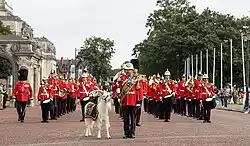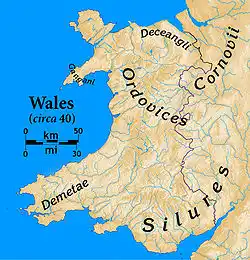
Welsh military records are records which have been produced by various armed forces in Wales over the last millennium. Going back far enough, Wales was an independent country and there are still some records extant today regarding Welsh military action against the English crown in the eleventh, twelfth and thirteenth centuries. However, since the full conquest of the country by King Edward I of England in the late thirteenth century, Wales has been largely politically subsumed within the English state. As such, most Welsh military records pertain to Welsh military units serving within the English army up to the Act of Union in 1707 and then the British armed forces thereafter. Welsh units played a huge role in the expansion of the British Empire and Britain’s involvement in the First and Second World Wars. Therefore, Welsh military records are a very useful genealogical tool for anyone with an ancestor that might have served in the military.[1]
Research your ancestors on MyHeritage
History of military forces in WalesHistory of military forces in Wales

There has always been a strong military tradition in Wales and a history of resistance to domination of the small country by foreign powers. In the first century CE, some of the staunchest resistance to the northward expansion of the Roman Empire in Britain was offered by the Ordovices of Wales.[2] The border between Wales and England today lies broadly along the path of Offa’s Dyke, a line of earthwork defenses which King Offa of Mercia ordered the construction of in the eighth century CE to defend his realm from Welsh incursions.[3] William the Conqueror might have been able to reduce England to Norman rule within a few years of his incursion into Britain and victory at the Battle of Hastings in 1066, but it took his successors two centuries to fully reduce Wales to English rule. Indeed, the first major military records for Wales extant today relate to the efforts of King Edward I of England to conquer the Welsh princes at the close of the thirteenth century.[4]
Thereafter Wales was gradually subsumed further into the English state. Consequently, the vast majority of Welsh military records today are an offshoot of the English and then British armed forces. However, Welsh military contingents generally retained their own individual character within the British military. The Royal Welch Fusiliers, for instance, was formed in 1689 at the commencement of the Nine Years’ War in Europe, fighting in Ireland in the early 1690s and in the Low Countries against the French in the years that followed. It continued to retain its own identity even after the Act of Union of 1707 created a unified Great Britain out of England, Scotland and Wales.[5]
Other Welsh regiments appeared at the height of the British Empire. The Welch Regiment, for instance, was formed in 1881 out of troops from Carmarthenshire, Pembrokeshire and Glamorgan. Divisions of it served in Egypt and Sudan during the Mahdist War and fought in the Second Boer War (1899–1902) in southern Africa. In 1914, upon the outbreak of the First World War, the Welsh Army Corps was established for Welsh servicemen. Divisions of it played a role in engagements such as the Gallipoli Campaign of 1915 in Turkey, on the Western Front in France and on various smaller fronts in the Middle East and in the Balkans.[6] More recently, the Prince of Wales’s Division was formed in 1968 out of the Welsh Brigade and Mercian Brigade. Today it is known as the Royal Welsh (distinct from the earlier Royal Welch) and is one of the core units of the British armed forces. It is believed that approximately 275,000 Welshmen served in both the First World War and the Second World War.
Where to find Welsh military records todayWhere to find Welsh military records today

Many records pertaining to military activity in Wales and forces from there will be found in the National Archives of the United Kingdom at Kew in London. This is owing to the manner in which Wales was so politically subsumed into England between the late thirteenth and sixteenth centuries and the tendency of the Victorian archivists who catalogued the vast State Papers series in the nineteenth century to not distinguish between England and Wales. Nevertheless, there are some records which are housed in Welsh archives and libraries.[7] A large proportion of the records for the Royal Welch are held in the Royal Welsh Fusiliers Museum at Caernarfon Castle.[8] Many regimental records are held by the National Library of Wales in Aberystwyth. Many records relating to Welsh servicemen are available through MyHeritage, notably records of those across Britain who lost their lives during the First World War.
What can be found in Welsh military recordsWhat can be found in Welsh military records
Depending on what time period is under consideration the level of detail found in different Welsh military records will vary. For the sixteenth, seventeenth and eighteenth centuries, for instance, many records are somewhat hit and miss. They were not systematically kept and muster rolls and other occasional records tended to record little more than the names of officers and payments made to maintain the unit. Where the rank and file soldiers were listed, there would simply have been a name provided, with perhaps an age and general place of habitation. The genealogical use of such records can be limited. For example, if one is looking for an ancestor called Rhys Davies in the 1750s, there will generally be little way of even identifying if a Rhys Davies listed in a muster roll or some other record was the individual in question, as this is such a common name in Wales.
We generally come to records which are much more detailed in the nineteenth century and especially so in the twentieth century. Veteran records from the First World War and Second World War, for instance, will provide a soldier’s name; enlistment number; date of birth; place of habitation upon enlisting; physical characteristics and health; as well as other records in some cases, like his profession prior to being conscripted or enlisting. The latter was recorded as people with particular skills were often ear-marked for certain units. An engineer, for instance, would often be assigned as a plane or tank mechanic during the Second World War.[9]
See alsoSee also
Explore more about Welsh military recordsExplore more about Welsh military records
- British Soldiers Died in the Great War, 1914-1919 records collection on MyHeritage
- Commonwealth War Graves, 1914-1921, 1939-1947 records collection on MyHeritage
- United Kingdom, War Memorials, 1914-1949 records collection on MyHeritage
- United Kingdom, British Army and Air Force Nominal Roll, 1920 records collection on MyHeritage
- British Army Roll of Honour, 1939-1945 records collection on MyHeritage
- Finding Evidence of Kinship in Military Records at Legacy Family Tree Webinars
References
- ↑ https://www.nam.ac.uk/subjects/wales
- ↑ https://www.roman-britain.co.uk/tribes/ordovices/
- ↑ https://www.english-heritage.org.uk/visit/places/offas-dyke/history/
- ↑ https://www.historic-uk.com/HistoryUK/HistoryofWales/The-English-conquest-of-Wales/
- ↑ Michael Glover and Jonathon Riley, That Astonishing Infantry: The History of the Royal Welch Fusiliers, 1689–2006 (Barnsley, 2008).
- ↑ https://www.nam.ac.uk/explore/welch-regiment
- ↑ https://discovery.nationalarchives.gov.uk/details/c/F100189
- ↑ https://www.rwfmuseum.org.uk/index.php
- ↑ https://www.nationalarchives.gov.uk/about/our-role/plans-policies-performance-and-projects/our-projects/ministry-of-defence-service-records/

